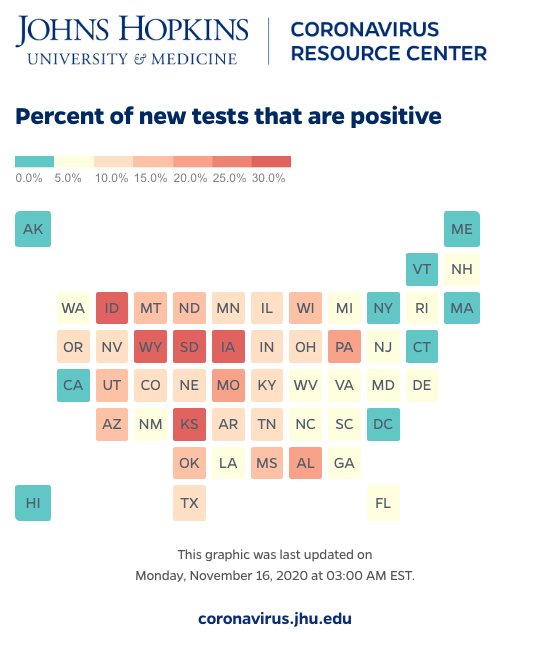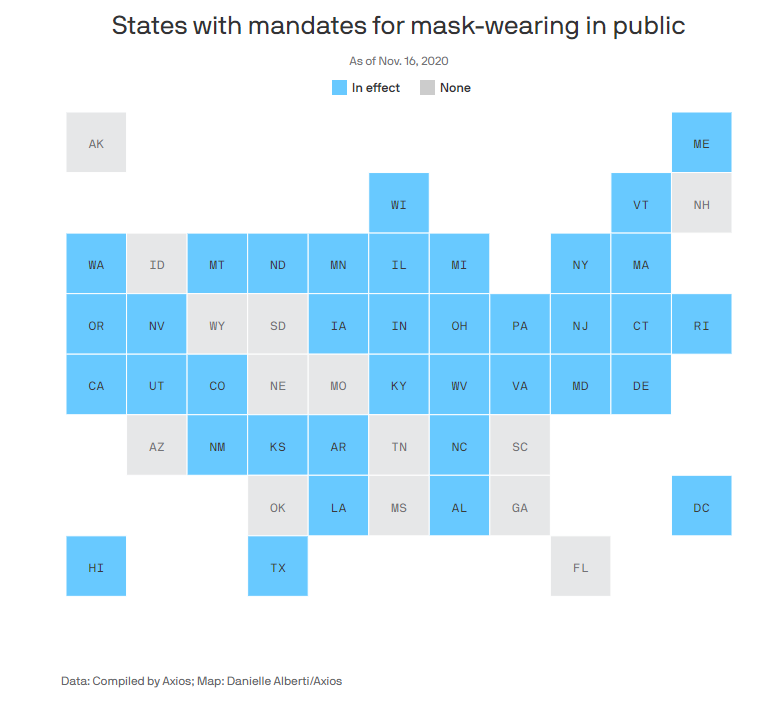Covid Spiking; Sweden Update; Success on a Reservation; Changing Public Opinions
The Science & Society Newsletter
The Covid-19 Situation Report
Global Numbers
55,147,032 cases
1,329,556 deaths
35,472,477 recovered
—Center for Systems Science and Engineering, Johns Hopkins University
Key Developments
More than 1 million children in the US have been diagnosed with COVID-19, making up 11.5% of the country’s overall caseload, according to the latest available state-level data. American Academy of Pediatrics/Children’s Hospital Association
Antigen tests not created equal: A new preprint study highlights that some of these rapid tests work much better than others, offering key insight into how to interpret and use these tests, according to the prominent epidemiologist Michael Mina.
A new study adds weakness, blood sugar problems, and gastrointestinal issues to the list of COVID-19 symptoms after analyzing some 12,000 ER visits at New York City hospitals. The Washington Post
Striking finding: Black patients hospitalized with COVID-19 were 28% more likely to be given a risker blood thinner compared to white patients, who more likely to receive an anticoagulant associated with better COVID-19 outcomes, according to a preprint study calling for further research into the disparity. Reuters
The Covid-19 Situation

Most American counties — 58% of them — have seen the peak of their coronavirus infections this month, and 76% of counties have peaked at some point in the fall.
Using a seven-day average of cases to smooth out daily variances in reporting, 97% of Midwestern counties cases peaked this Fall.
22% of the Northeast peaked in the spring, led by the New York City metro area.
Western and Southern states had the largest shares of counties peak during the summer.
Peaking does not necessarily mean that a location has herd immunity. It just means that the worst day for a location happened in the fall. There were places that had peaks in the spring that are peaking in fall now since the fall outbreak is larger.

Only 34% of U.S. counties' peak caseloads came during the spring or summer waves.
April had the most peaks in the spring with 83 counties, and July led the summer with 300 counties.

Axios-Ipsos poll: The coronavirus wakeup call

More Republicans, in particular, have begun to acknowledge the risks of indoor activities. Republicans are less concerned about the coronavirus, by almost any measure, but Republicans and independents are beginning to come around on the risk of indoor dining and socializing, and that's what's driving the overall increase in risk perception. That's a positive sign for the US that could provide the needed cooperation for an effective response.
39% of Americans say attending indoor gatherings of family and friends would be highly risky — up from 28% in our last survey, conducted about three weeks ago.
Similarly, there was an 11-point jump in the number of people who said dining inside a restaurant is high-risk.
Science & Society Stories
WHO Unveils Plan to Eliminate Cervical Cancer
The WHO unveiled a new 3-part strategy today to rid the world of cervical cancer, saving the lives of ~5 million women and girls.
The resolution adopted by 194 countries at this year’s World Health Assembly seeks to reduce new cases by 40% by 2050. It marks the first time the world has committed to eliminating a type of cancer.
The roadmap sets out 3 targets to reach by 2030:
90% HPV vaccination coverage of girls by age 15
70% screening coverage for women by age 35 and again by 45
90% access to treatment for cervical pre-cancer and cancer, including access to palliative care
Why It Matters: Cervical cancer is the 4th most common cancer among women globally—and the only vaccine-preventable cancer. And yet:
Cases could climb to 700,000, with 400,000 associated deaths, by 2030 with no action.
Death rates are 3X higher for low- and middle-income countries than wealthier nations.
One Big Hurdle: There are 3 vaccines to combat HPV, but availability is skewed towards richer countries, UN News reports.
Related: Estimates of the global burden of cervical cancer associated with HIV - The Lancet Global Health
How Has Sweden's Strategy Panned Out?
The world has closely watched Sweden’s light-touch approach to pandemic restrictions. Now, like many of its neighbors, the country’s cases are surging—possibly at the fastest rate in Europe.
Swedish officials have denied striving for a form of natural herd immunity, but they did predict a milder second wave compared to countries with strict lockdowns. That has not panned out—immunity in and around Stockholm is much lower than predicted.
While the outcome isn’t good for Sweden or its stricter counterparts, the fresh waves in other countries “might suggest Sweden’s decision not to lock down has not played a significant role in the recent surge in infections.”
Related:
Rebecca Kaplan: The idea of herd immunity to manage the coronavirus should ring alarm bells
Cherokee Nation’s Standout Response
Overall, American Indian and Alaskan Native populations have COVID-19 case rates 3.5X higher than whites—but the breakdown is far from even.
With a mask mandate in place since spring, free drive-through testing, hospitals well-stocked with PPEs, and a “small army” of public health workers, the Cherokee Nation has fared far better than other tribal areas and the US as a whole, STAT reports.
Navajo Nation—which has just entered another lockdown, NPR reports— has seen 13,000 cases and 602 deaths compared to 4,000 cases and 33 deaths in Cherokee Nation, which has a similar population size.
The Cherokees’ success is no miracle. Already boasting the nation’s largest tribal health system, Cherokee health officials acted early, hosting twice-daily briefings and stockpiling PPE. Absent any federal guidance, they proactively emulated WHO’s Ebola contact tracing strategy. Crucially, the tribal governor respects public health professionals’ recommendations.
“I feel I have several Dr. Faucis.”
Principal Chief Chuck Hoskin, Jr.
Related: Canada's remote Nunavut to impose COVID-19 lockdown after community outbreak – Reuters
RESEARCH
Declines in SARS-CoV-2 Transmission, Hospitalizations, and Mortality After Implementation of Mitigation Measures— Delaware, March–June 2020
State-mandated stay-at-home orders and public mask mandates coupled with case investigations with contact tracing contributed to an 82% reduction in COVID-19 incidence, 88% reduction in hospitalizations, and 100% reduction in mortality in Delaware during late April–June. The combination of state-mandated community mitigation efforts and routine public health interventions can reduce the occurrence of new COVID-19 cases, hospitalizations, and deaths. (CDC MMWR, 11/13/2020)
Associations Between Blood Type and COVID-19 Infection, Intubation, and Death (Nature Communications) Here, we use observational healthcare data on 14,112 individuals tested for SARS-CoV-2 with known blood type in the New York-Presbyterian (NYP) hospital system to assess the association between ABO and Rh blood types and infection, intubation, and death.
They found a slight increase in infection prevalence among non-O types.
It’s Now Up to Governors to Slow the Spread
(WSJ) The Covid response has been a joint effort, with the federal government working to support states overseeing their own local mitigation efforts. But the White House is changing hands during the most critical point of the pandemic, and it’s a particularly important time for leadership from governors, mayors, and county administrators. State and local actions, supported by improved treatments, can help build a bridge to vaccinations and more widespread immunity in 2021.
Iowa Governor Reverses Course, Issues Mask Mandate As COVID-19 Cases Rise
(NPR) As hospitals in Iowa fill up with COVID-19 patients amid a major surge in cases in recent weeks, Gov. Kim Reynolds, who once dismissed coronavirus restrictions as "feel-good" measures, has abruptly reversed course, issuing the state's first mask mandate.
The Department of Defense, in coordination with the Department of Health and Human Services, awarded a $6.18 million contract to Medline Industries, Inc. to increase the domestic production capacity of surgical masks. This industrial base expansion effort will allow Medline to increase production capacity in Lithia Springs, Georgia by 36 million surgical masks per month by May 2021. (DOD, 11/16/2020)







